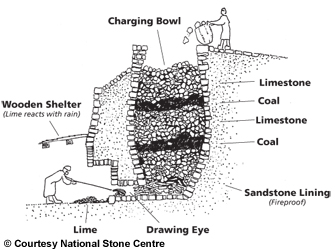About Lime
We all too often hear people say “ just use lime” as if that’s a good enough instruction for a mortar mix. This lack of understanding is misguiding and in a lot of cases the wrong type of lime in a mortar mix can be just as damaging as cement.
In this note, we try to simplify what we and our peers know so that you might feel a little more informed on the subject.
Lime can generally be categorised into two types:
- Non Hydraulic Limes(putty and quicklime)
- Natural Hydraulic Lime (NHL and Natural Cements)
The main differences between the two types are;
- Non Hydraulic Limes are pure lime and made by burning limestone in a lime kiln. They set by carbonating and sometimes have additives (silica) mixed in with the mortar mix to help provide hydraulic and stronger final sets, theses additives are known as Pozzolans;
Pozzolan additives in mortars were developed by the Romans. Examples of the durability of these mortars can be seen at places like Richborough Roman fort;
https://www.english-heritage.org.uk/visit/places/richborough-roman-fort-and-amphitheatre/
- Natural Hydraulic Limes set by adding water to them and have certain percentages of clay in the lime, which gives them their final set strength, they also set with carbonation but not as much as pure limes.
During the hundred years between 1750 and 1850 major discoveries were found about mortar properties. The relationship between limestone and clay impurities were not understood before John Smeaton’s work in the 1750’s that confirmed the link between the clay (silica) content in lime and hydraulicity. Ramsgate Harbour for instance is one of Smeatons ‘ notable works’ ;
https://www.ice.org.uk/what-is-civil-engineering/civil-engineer-profiles/john-smeaton
Both types of lime have their place in traditional mortar mixes but careful consideration must be given to which type is used.


Important note;
Extensive research was carried out by English Heritage under the guidance of Professor John Ashurst as there seemed to be inconstancies with the classification of NHL’s by the different manufacturers. It was found that the clay content in the NHL’s varied by significant amounts; some NHL2’s were found to be equivalent to NHL 3.5 and some NHL 3.5 were equivalent to NHL 5. This was leading to the wrong mortar specifications and historic masonry was being damaged as a result.
The French lime manufacturer – St Astier worked with John Ashurst and English Heritage and St Astier produced relevant technical information on the amount of clay in their lime and have produced tables setting out their mortars final sets.
The designations (2 – 3.5 -5 ) for NHL’s is modern cement test and is measured at 28 days as this is how long it takes cement to set after mixing , whereas lime takes 24 months to reach final set.
Note; some ( St Astier) NHL 2 mortars can have a final set that is equivalent to NHL 3 and NHL 4.25.
See link;http://www.stastier.co.uk/nhl/data/nhl2.htm
Only St Astier NHL’s can be used/ recommended in historic/ pre-1919 construction as they are they only manufacturer that provides technical data on the final set strengths and therefore the only reliable source of lime.
St Astier NHL 2 has a final set strength that would be equivalent historic ‘moderately hydraulic’ lime (defined by Smeaton) and should be considered the maximum strength for most mortar mixes for most traditional masonry units.
The use of traditionally slaked lump lime / hot mixed quick lime mortars have seen a renaissance in recent years and extensive study has been carried out Nigel Copsey, the Building Limes Forum, staff at Historic England and Historic Environment Scotland.
See Link to Nigel Copsey’s book below for the most up to date information on the subject.
The ideal time to complete external lime work works is between April and September this is to prevent frost damage. A temperature of over 6 degrees ºc is required to ensure set in hydraulic mortars. Lime work should be damped down regularly after application, this is particularly important during the summer and windy conditions.
For information on lime work , see these websites for information and guidance;
And these publications:
- Hot Mixed Lime and Traditional Mortars: A Practical Guide to Their Use in Conservation and Repair. By Nigel Copsey
https://www.waterstones.com/book/hot-mixed-lime-and-traditional-mortars/nigel-copsey/9781785005558
Practical Conservation Series by English Heritage/ Historic England, Volumes:
- Mortars, Renders & Plasters
- Earth Brick and Terracotta
- Stone
- Roofing
https://historicengland.org.uk/advice/technical-advice/buildings/practical-building-conservation/
- Period Property Manual by Haynes – an excellent book for the home owner and professional alike
https://www.mikewye.co.uk/product/period-property-manual-haynes/
